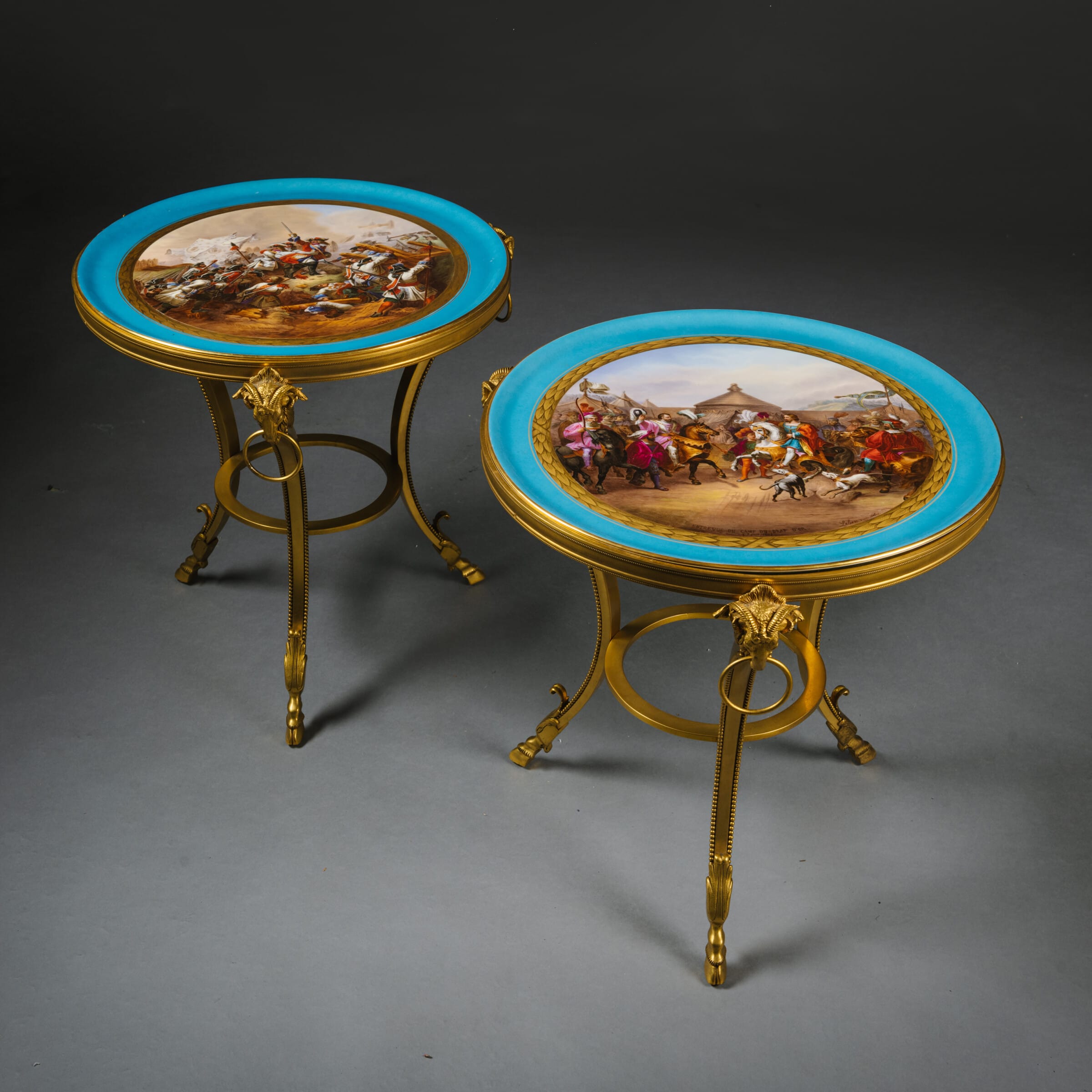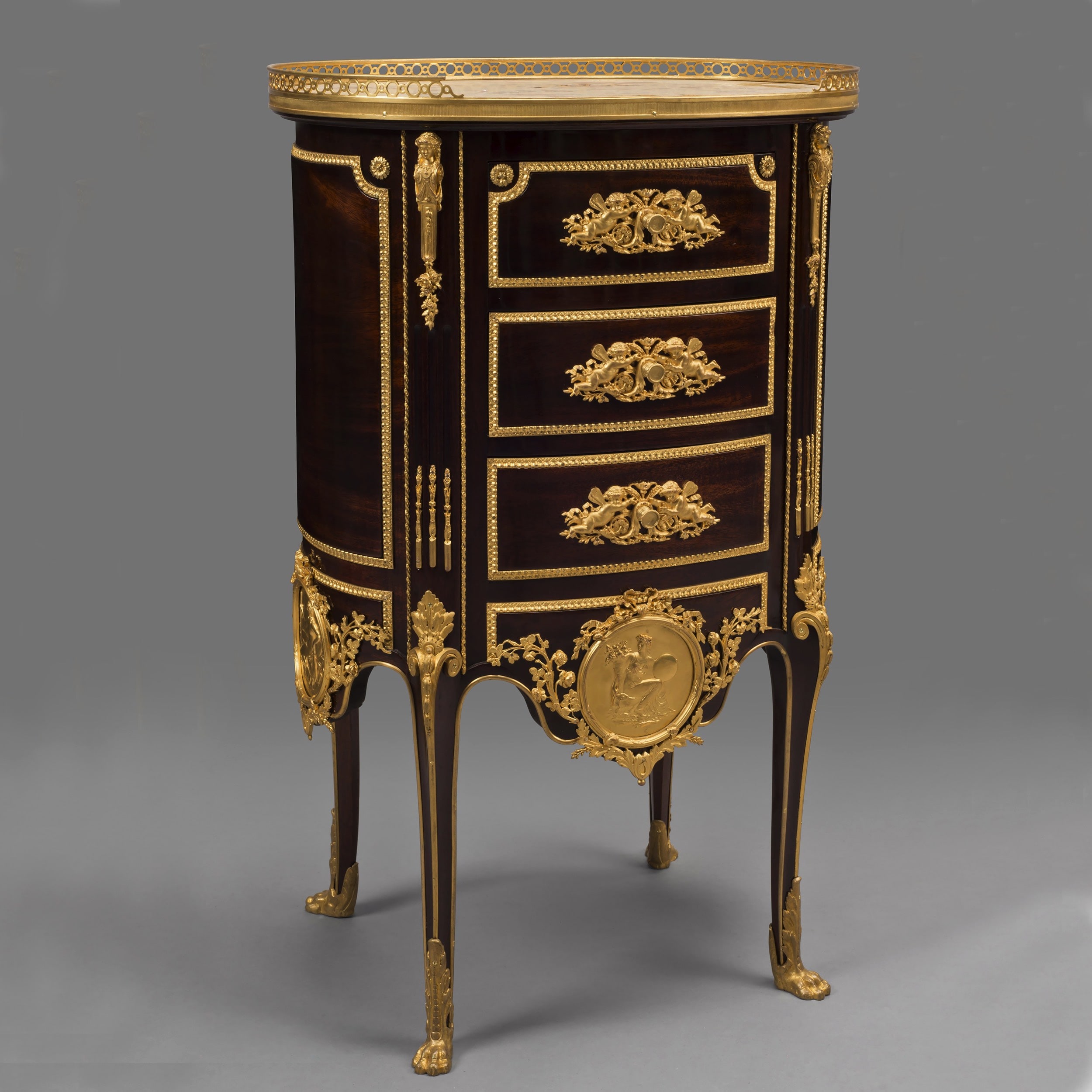Sèvres (Style)
An Unusual Pair of Louis XVI Style Gilt-Bronze Low Side Tables With Sèvres-Style Porcelain Tops
£18,000
A Fine and Unusual Pair of Louis XVI Style Gilt-Bronze Low Side Tables With Sèvres-Style Porcelain Tops. Each table has a fine Sèvres-style porcelain...
Dimensions
Height: 49 cm (20 in)Diameter: 46 cm (19 in)
Description
A Fine and Unusual Pair of Louis XVI Style Gilt-Bronze Low Side Tables With Sèvres-Style Porcelain Tops.
Each table has a fine Sèvres-style porcelain charger painted with historical battle scenes within bleu céleste borders supported on finely cast gilt-bronze tripod bases, the beaded legs headed by rams head masks and united by a circlet, terminating in acanthus and hoof feet.
The large and finely painted porcelain chargers are signed by the studio porcelain artist Leber and titled ‘Le Bataille de Denain’ (24 Julliet 1712) and ‘Entrevue du Camp du drap d’or’ (7 Juin 1520).
The Battle of Denain was fought on 24 July 1712 as part of the War of the Spanish Succession. It resulted in a French victory, under Marshal Villars, against Dutch and Austrian forces, under Prince Eugene of Savoy. The depiction by Leber is after the famous painting by Jean Alaux (1764-1894) in the Galerie des Batailles at the Palace of Versailles, exhibited at the Salon in 1839.

Jean Alaux (1764-1894) ‘‘Le Bataille de Denain’.
Photo (C) RMN-Grand Palais (Château de Versailles) / image RMN-GP
The Camp or Field of the Cloth of Gold is the name given to the famous diplomatic meeting which took place between King Francis I and Henry VIII of England from June 7 to 24, 1520, in the North of France, in Balinghem near of Calais. The depiction by Leber is after the painting by Auguste-Hyacinthe Debay (1804-1865), of 1837 now in the Place of Versailles.

Auguste-Hyacinthe Debay (1804 – 1865) ‘L’Entrevue du camp du Drap d’Or le 7 juin 1520’
Photo (C) RMN-Grand Palais (Château de Versailles) / image RMN-GP
The beauty of the tables lies principally in the finely painted scenes, which are painted with great delicacy and precision.
Each charger titled to the reverse and with spurious Sèvres marks.
French, Circa 1890.
Date
Circa 1890
Origine
France
Moyen
Bronze doré et porcelaine
Signature
The porcelain chargers signed 'Leber' and titled to the reverse.
The Sèvres Porcelain Manufactory was founded to the east of Paris in the disused Royal Château of Vincennes, late in 1739-40. and moved to the village of Sèvres, west of Paris in 1756, en route to King Louis XV’s palace of Versailles.
Here it was also adjacent to Louis’s mistress Madame de Pompadour’s own château at Bellevue. She was delighted with the factory’s new location – as she knew she could entice Louis to take a greater interest in it when it was so near their own residences. Indeed, the King became such a keen patron of the factory that, when it ran into financial difficulties, he bought out the shareholders and became the sole proprietor. The factory remained a royal enterprise until the French Revolution, when it was nationalised.
The popularity of the Louis XV style during the nineteenth century led to a number of companies in and around Paris, creating exceptional Sèvres-Style porcelain based on eighteenth century models and to the same exceptional quality. Often these pieces were of exhibition quality and scale, and finely painted by the best studio painters of the day such as Robert, Desprez and Poitevin.


















 Imprimer
Imprimer


